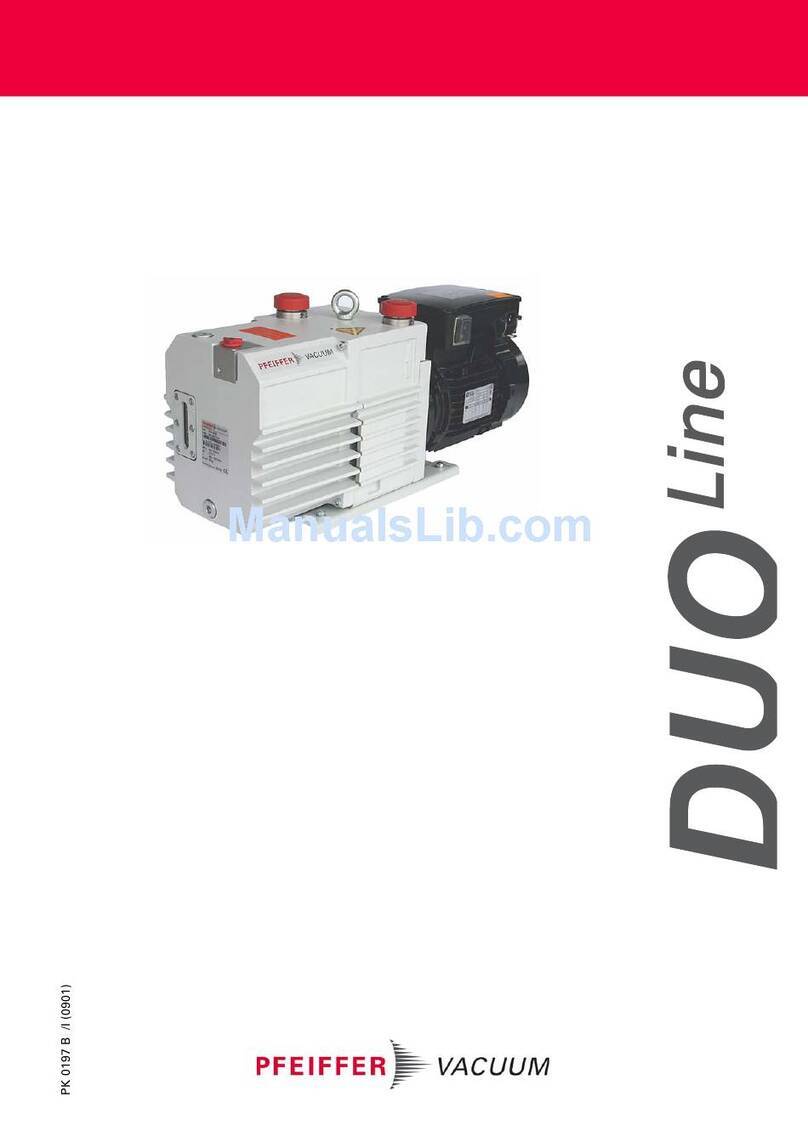3
Obey all relevant safety requirements (regulations and guide-
lines) and adopt suitable safety measures.
☞Read and follow all the instructions in this manual.
☞Inform yourself regarding:
- Hazards which can be caused by the pump;
- Hazards which can arise in your system;
- Hazards which can be caused by the medium being
pumped.
Use the equipment for the intended use only (for generation
of vacuum).
☞Avoid exposing any part of the body to vacuum.
☞Adopt suitable measures to prevent any danger arising
from the formation of hot surfaces or electric sparks.
☞Obey notes on correct vacuum and electrical connections,
see section ”Use and operation”.
☞Make sure that the individual components are only
connected, combined and operated according to their
design and as indicated in the instructions for use.
☞Observe all safety and accident prevention regulations.
☞Check regularly that all safety requirements are being
complied with.
☞Do not carry out any unauthorized conversions or
modifications on the pump.
☞Check that mains voltage and current conform with the
equipment (see rating plate).
☞The mains connection must be subject to a safe
connection to the PE.
☞Pay attention to the condition of cable insulation.
☞The user must take suitable precautions to prevent any
formation of explosive mixtures in the expansion chamber.
Mechanically generated sparks, hot surfaces or static
electricity may ignite these mixtures.
☞Adopt suitable measures to prevent the release of dange-
rous, explosive, corrosive or polluting fluids.
☞Take adequate precautions to protect people from the
effects of dangerous substances, wear appropriate safety
clothing.
☞Obey applicable regulations when disposing of chemicals.
Take into consideration that chemicals may be polluted.
Due to the residual leak rate of the equipment, there may be
an exchange of gas, albeit extremely slight, between the envi-
ronment and the vacuum system.
☞Adopt suitable measures to prevent contamination of the
pumped substances or the environment.
Electronic equipment is never 100% fail-safe. This may lead to
an indefinite status of the equipment. Provide protective
measures against malfunction and failure.
☞Stopping of the pump or operating a valve must not lead to
a critical dangerous situation under any circumstances.
Ensure that in case of failure the pump and the vacuum
system always will turn into a safe status.
☞In the event of cracks or leaks in the manifold pumped
substances might be re-leased into the environment or into
the pump housing.
☞Especially obey notes on operation, use and maintenance.
☞Use only genuine spare parts and accessories.
☞Otherwise safety and performance of the equipment as
well as the electromagnetic compatibility of the equipment
might be reduced.
☞Ensure that maintenance is done only by suitably trained
and supervised technicians.
Ensure that the maintenance technician is familiar with the
safety procedures which relate to the product processed
by the vacuum system and that the equipment, if
necessary, is appropriately decontaminated before
starting maintenance.
☞Obey local and national safety regulations.
Before starting maintenance vent the system, isolate the
pump and other components from the vacuum pump and
the electrical supply and allow sufficient cooling of the
pump.
☞When returning the pump to us please note the shipping
instructions in Section 7.
1. Safety Precautions




























